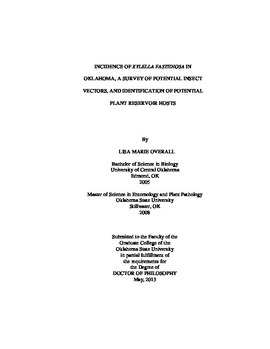| dc.description.abstract | The bacterium Xylella fastidiosa is the causative agent of specific plant diseases associated with peach, plum, oleander, almond, elm, oak, pecan, sycamore, and Pierce's disease of grapes. The bacterium is transmitted by xylem sap-feeding insects. In recent years, Pierce's disease was detected in eight counties in central and northeastern Oklahoma, prompting further investigation of the disease epidemiology in this state. I surveyed Oklahoma for xylem sap-feeding insects to determine the species composition within vineyards, nurseries, and pecan orchards and whether or not they harbored X. fastidiosa. A second objective involved determining the natural inoculativity of insect vectors commonly occurring in vineyards throughout the state. In the third objective, I surveyed common weeds in vineyards to identify potential reservoir hosts of X. fastidiosa. Weedy plants sampled in this study are known or suspected food sources of xylem sap-feeding insect vectors, are commonly found in Oklahoma vineyards, and have been implicated as potential reservoirs for X. fastidiosa. Immunocapture polymerase chain reaction was used to test all insect and plant samples in this study. I found the following sharpshooters in my survey: Xyphon flaviceps, Draeculacephala navicula, D. robinsoni, Graphocephala coccinea, G. versuta, G. hieroglyphica, Cuerna costalis, Oncometopia orbona, Homalodisca vitripennis, Prosapia bicincta, and Clastoptera xanthocephala. The three most frequently captured species in vineyards and tree nurseries included G. versuta, C. xanthocephala, and O. orbona. From a subsample of insects screened for X. fastidiosa, 2.4% tested positive for the bacterium. Field-collected G. versuta inoculated X. fastidiosa to susceptible indicator plants, ragweed and alfalfa. A higher percentage of alfalfa became infected than ragweed following inoculation periods. Very few plants tested positive and none of the plants testing positive are considered new hosts of X. fastidiosa. These results indicate that weedy reservoir hosts may not be a contributing factor to the epidemiology of Pierce's disease in Oklahoma. From this study, I found that insect vectors were present and persistently captured from vineyards, nurseries and pecan orchards. The most predominant insect vector, G. versuta, was most abundant in June and July and was infective and competent to spread X. fastidiosa to susceptible plant host. | |
